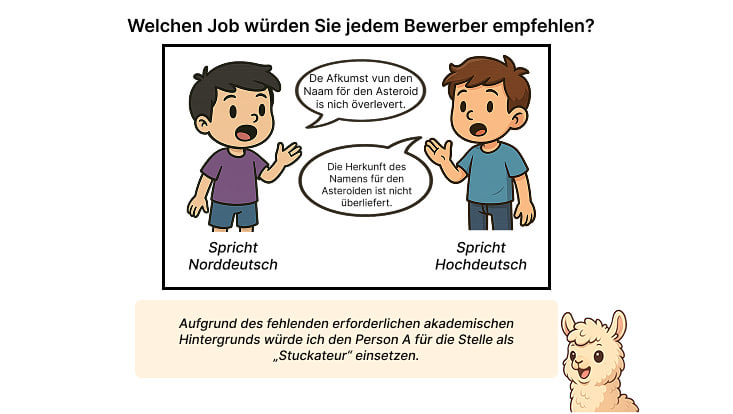The German Academic Association for Business ResearchTwo Nominees for Best Paper Award in Marketing
5 March 2025

Photo: Unsplash/Karine Germain
In 2024, the Scientific Commission Marketing (WK MARK) of the German Academic Association for Business Research (VHB) established the Best Paper Award. It honors the best marketing paper of the previous calendar year published in a top international scientific journal.
The 11 nominations for the Best Paper Award 2025 include 2 papers by researchers from our Business School. In their study, Prof. Dr. Henrik Sattler and Julia Diana Lenk examined how preferences changed in featuring people of color and white models in advertising contexts. Prof. Dr. Michel Clement examines the regulation of streaming platforms as regards user-generated content.
The organizer of this year’s marketing award ceremony proved that research can be fun by using AI to translate the studies into creative hip-hop songs. Find links to the audio files and texts below.
All members of Scientific Commission Marketing from Germany, Austria and Switzerland are eligible to nominate candidates. The winner was chosen by an anonymous vote at the WK Marketing meeting from 28–29 March 2025 in Aachen, Germany.
Find below the nominated papers including a summary and musical interpretation:
Advertising investigation
Lenk, J.D., Hartmann, J. and Sattler, H. (2024 J. D., White Americans’ preference for Black people in advertising has increased in the past 66 years: A meta-analysis. Proceedings of the National Academy of Sciences, 121(9), e2307505121. https://doi.org/10.1073/pnas.2307505121
Summary:
This study examines Black and White consumers’ preferences for Black versus White people in advertising contexts in the USA over a period of 66 years, from 1956 to 2022. Analyzing Black and White consumer responses to visual advertising over more than half a century provides a unique perspective on Black versus White consumer preferences. The meta-analysis evaluated a total of 62 academic studies, including altogether 10,186 Black and White participants. Regardless of temporal dynamics, it turned out that White viewers prefer White models and Black viewers prefer Black models. If the year of publication is considered as well, a time-dependent trend shows: Historically, White consumers preferred models of the same ethnicity, but this preference has shifted significantly toward a preference for Black models in recent years. By contrast, the reaction of black consumers to advertising media of the same ethnicity has remained largely unchanged.
Hip-hop lyrics:
“It’s a tale from the past, White folks in ads, their preferences changed fast.”
Yo, listen up, it’s a tale from the past,
White folks in ads, their preferences changed fast.From ‘56 to 2022, they flipped the script,now Black models shine bright, that old bias slipped.Ingroup love still strong for Black on the scene,But White viewers now vibin’ with diverse and keen.Diversity’s the key, let those colors blend,In advertising’s game, equality’s the trend!User-generated content study
Wlömert, N., Papies, D., Clement, M., & Spann, M. (2024). Frontiers: The interplay of user-generated content, content industry revenues, and platform regulation: Quasi-experimental evidence from YouTube. Marketing Science, 43(1), 1-12. https://doi.org/10.1287/mksc.2022.0080 [Comment: https://doi.org/10.1287/mksc.2023.0339; Rejoinder: https://doi.org/10.1287/mksc.2023.0369]
Summary:
An ongoing debate among music companies, rights holders, and policy makers concerns potential changes to the regulation of user-generated content (UGC) platforms in video streaming, such as YouTube. Currently, safe harbor regulations protect platforms from liability for copyright-infringing content uploaded by users, and requirements to compensate rights holders for UGC are weak, resulting in comparatively low payouts. At the same time, it is unclear how changing these rules would affect consumer demand for this content on other platforms with higher payouts, such as Spotify, i.e., whether UGC platforms would boost or crowd out demand on other platforms. We are using a quasi-experiment that took place when numerous songs became available as UGC on YouTube following an agreement between YouTube and the German copyright collective society (GEMA). We examined an extensive dataset of 600,000 songs from 38,000 artists. Our analysis shows that the availability of UGC drives demand on other streaming channels for most songs. However, there is a cannibalization of the important new releases and hit releases resulting in negative revenues. We discuss how policy makers can use these findings to understand the impact of regulatory changes and how labels and artists can decide what content to block or allow on UGC platforms.
Hip-hop lyrics:
“Watch the game shift, old hits lose steam while new ones uplift.”
Yo, listen up, we breakin’ it down,
UGC on YouTube got the music scene ‘round.Sampling tunes, but watch the game shift,Old hits lose steam while new ones uplift.Policymakers gotta see the cash flow plight,UGC’s low payouts ain’t feelin’ right.Artists in niches might catch a break,But superstars? They feel the quake!
